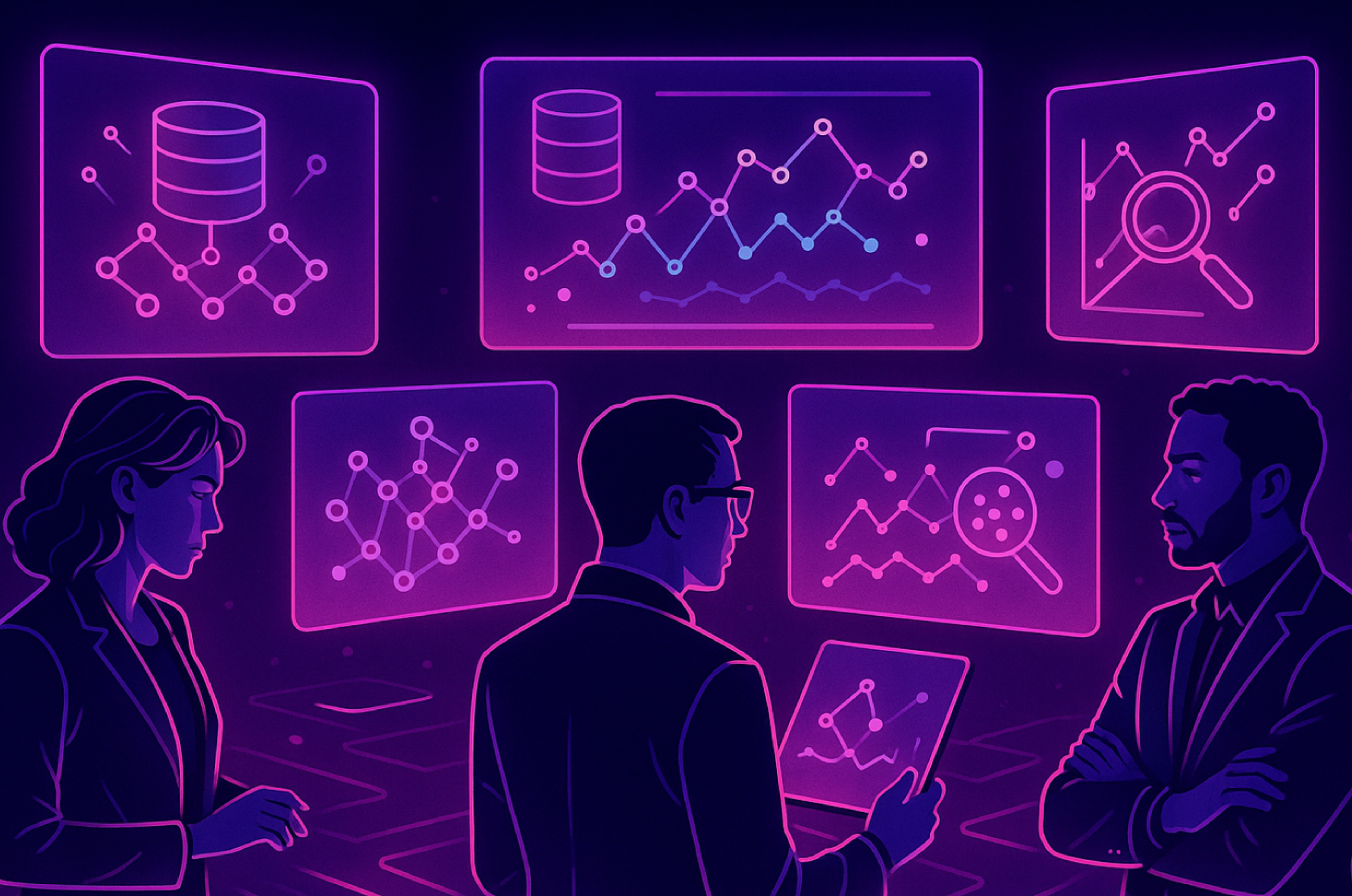Apache Cassandra® and MongoDB are two of the most widely adopted NoSQL databases. Unlike relational databases, NoSQL databases do not require a fixed schema, eliminating the need for data normalization and relational mapping. This also enables them to handle a wider range of data types — including structured, unstructured, and semi-structured data. They also excel at querying very large data sets (think terabytes).
As a result, NoSQL databases are the go-to solution for storing and querying the massive volumes of data needed for AI use cases.
But not all NoSQL databases are the same — they might take dramatically different approaches to how they store data, for instance, which impacts their best use cases.
Here, we’ll take a look at two of the top NoSQL databases — Cassandra and MongoDB —exploring their similarities and their important differences to help you understand which may be the best fit for feeding your generative AI (GenAI) app data needs.
NoSQL database basics
NoSQL databases emerged in the early twenty-first century as a response to the explosion of data managed by companies like Facebook, Google, and Netflix. These and other tech giants were generating, storing, and querying data at volumes that were inconceivable to earlier generations of DB admins, and the volumes were quickly overwhelming traditional relational databases.
To meet the new challenges, engineers designed NoSQL databases specifically for storing large amounts of structured or semi-structured data at scale with lightning-fast reads. Additionally, NoSQL databases are generally architected to be distributed by nature, with data stored across multiple servers or nodes using range or hash distributions.
As a result, a NoSQL system can be scaled horizontally to meet demands. This architecture overcomes the challenge of scaling faced by traditional relational databases, which usually need to be scaled vertically, i.e., migrated to a beefier server.
To address the need for storing and querying structured, unstructured, and semi-structured data, NoSQL databases use one of four data models:
- Key-Value Model – data is stored as key-value pairs.
- Document Model – data is stored as structured documents, typically in JSON or BSON.
- Wide-Column Model – data is stored in tables, but with flexible and sparse columns.
- Graph Model – data is stored as nodes and edges, representing entities and relationships.
These models enable NoSQL databases to take a flexible approach to data schema, which allows for changes in the structure of data without disrupting the application or requiring downtime.
For more details about NoSQL databases, their architecture, and use cases, check out our guide to NoSQL databases.
Cassandra key features and capabilities
Cassandra was originally created at Facebook to support their in-box search functionality. It was open-sourced in 2008, and the project joined the Apache Software Foundation in 2009. It’s currently in use at Netflix, X (Twitter), and thousands of other companies.
Cassandra employs a wide-column data model, which provides flexible schema at the row level (i.e., each row in a table can have a different set of columns). It enables users to access only the specific columns they need without allocating additional memory to irrelevant data.
Cassandra is a distributed system, running across as many machines as you desire, but it appears to users as a single instance, reducing programming complexity. Cassandra uses a seamless replication scheme to scale across hybrid clouds and ensure fault tolerance
It also has a peer-to-peer architecture, meaning that any node can provide the exact same functionality as any other node — there is no single point of failure.
While each node in Cassandra is functionally identical, data can be replicated to multiple nodes (with the precise number being configurable), ensuring reliability and fault tolerance. Data is partitioned across cluster instances based on a partition key with a hash function applied.
This design contributes to Cassandra’s high availability and performance. Cassandra really shines when operating on petabytes of data and thousands of operations per second.
Cassandra uses a customized version of SQL called Cassandra Query Language (CQL). While very similar to SQL, CQL includes key differences to interact with distributed, non-relational data, but users familiar with SQL quickly pick it up.
MongoDB key features and capabilities
MongoDB was created at 10Gen as part of a platform-as-a-service they were creating in 2007. The company pivoted to focus on MongoDB and renamed itself to match the product.
10Gen released MongoDB as an open-source project in 2009. It is currently available as a free, open source edition, an enterprise edition that runs in your own infrastructure (on-prem or cloud), and as software-as-a-service (SaaS).
MongoDB employs a document data model. Data is primarily stored as BSON, a binary representation of JSON developed by MongoDB, which optimizes for speed and efficiency as well as providing some non-native JSON data types (e.g., dates and binary data). However, conversion from JSON to BSON and BSON back to JSON for output is handled automatically within MongoDB.
Developers typically appreciate the ease of working with MongoDB. They can load documents easily into JavaScript and any other language with JSON reader functionality.
Like Cassandra, MongoDB handles horizontal scaling and geographic distribution well. Unlike Cassandra, though, MongoDB utilizes a primary/secondary model for its distributed architecture, with the primary instance handling all writes.
This model provides strong consistency by default because all clients are writing to a single source of truth. However, it also creates a single point of failure for writes. To compensate, MongoDB monitors the primary and provides automatic replica set election to promote a secondary to primary in the event of failover.
Like Cassandra, MongoDB uses a custom version of SQL called MongoDB Query Language (MQL). While conceptually similar to SQL, MQL is syntactically very different.
Common use cases for Cassandra and MongoDB
Cassandra is ideal for high-throughput, globally distributed, write-heavy workloads where availability and scalability are critical, including:
- Internet of Things (IoT) applications
- Real-time analytics, especially where usage is spikey
- Geographically distributed applications
- Systems where no downtime is allowed
MongoDB is ideal for document-centric, flexible-schema use cases that benefit from developer agility and strong consistency, including:
- Content management systems (CMS), especially where content types and structures vary
- Product catalogs and e-commerce
- Logging
- Rapid prototyping
Key differences between Cassandra and MongoDB
Licensing
As a member of the Apache Foundation, Cassandra is available under the Apache License 2.0, which provides for free use, modification, distribution, and private use — including in proprietary software.
MongoDB is available under the less permissive Server Side Public License (SSPL) v1, which the Open Source Initiative (OSI) guidelines do not consider to be truly "open source."
Deployment
MongoDB is typically easier to get up and running than Cassandra. A single node instance is easily deployed in Docker, making it ideal for quick prototyping. While it is also possible to run a single-node local version of Cassandra, running a production version typically requires more ops expertise than does MongoDB.
Availability
Cassandra’s peer-to-peer design virtually eliminates downtime. With a thoughtful deployment strategy, it could survive a data center outage or even an entire cloud provider collapse.
MongoDB’s primary/secondary design provides a single point of failure. While its failover detection and recovery processes are robust, they do result in downtimes lasting from several seconds to a few minutes.
Concurrency and consistency
Cassandra’s peer-to-peer design also gives it an edge over MongoDB in terms of concurrency since any node can perform any action, eliminating bottlenecks.
However, Cassandra’s high concurrency comes at the cost of consistency — Cassandra is eventually consistent as data changes replicate across the nodes.
With its primary node being the only one to receive writes, MongoDB is highly consistent by default. It provides document-level locking, supports MVCC (Multi-Version Concurrency Control) at the transaction level, and is fully ACID compliant, while Cassandra offers row-level atomicity at the partition level.
Programming languages
While both MongoDB and Cassandra offer broad programming support, MongoDB supports more languages than Cassandra. MongoDB supports the most common languages used for mobile app development, such as Swift, Kotlin, and Flutter.
Choosing between Cassandra and MongoDB
When it comes to choosing between Cassandra and MongoDB, they are both great products with thousands of happy users. For many use cases, you can use either one successfully.
Because of its JSON document model, however, MongoDB provides schema flexibility that Cassandra cannot match. That often makes it a compelling choice for the early stages of a project as applications evolve rapidly.
However, for long-term use in production, Cassandra’s extreme scalability and uptime are hard to beat. And, of course, performance, ease of administration, and cost are always considerations.
DataStax Astra DB, built on top of Cassandra, provides a Cassandra-style solution that’s easy to deploy and maintain — and with better performance and lower cost.
Astra DB is completely serverless; there’s nothing to install, and Astra handles scaling for you automatically.
Astra DB is also significantly less expensive to run than MongoDB, with up to 60% savings in total cost of ownership (TCO). DataStax makes it easy for teams transitioning from MongoDB to Astra DB with the Data API, which is compatible with the MongoDB API.
Where Astra DB excels is with our native vector search capabilities for powering GenAI use cases. Tests confirm that Astra DB offers 45% better performance than other vector database solutions such as Pinecone. DataStax also offers a powerful AI platform that enables developers to build powerful AI apps and agents with Langflow’s intuitive framework and one-click deploy at scale.
Conclusion
Cassandra and MongoDB are both excellent database management systems capable of handling large amounts of data and scaling to meet demand.
They differ in some fundamental ways, however, most significantly in the data models they use and their approach to high availability, which makes them better suited to different use cases.
Astra DB offers teams all of the power and functionality of Cassandra (and more!) while removing the hassle of managing infrastructure, letting you focus on building and innovating your AI apps faster and less expensively.
Try Astra DB with Langflow for free today.




